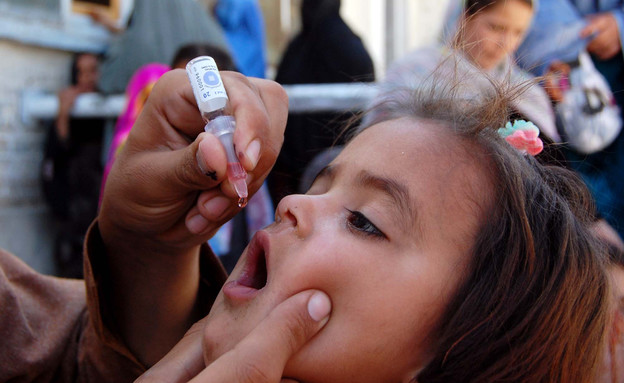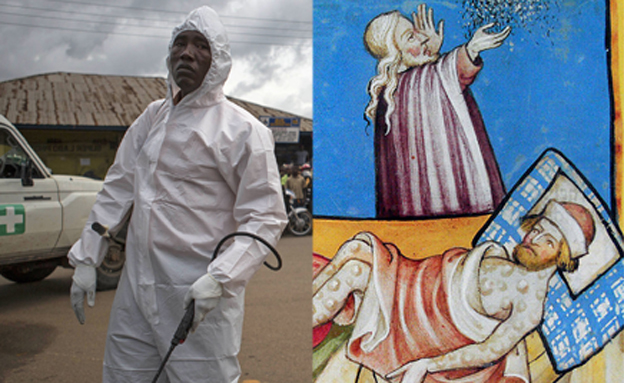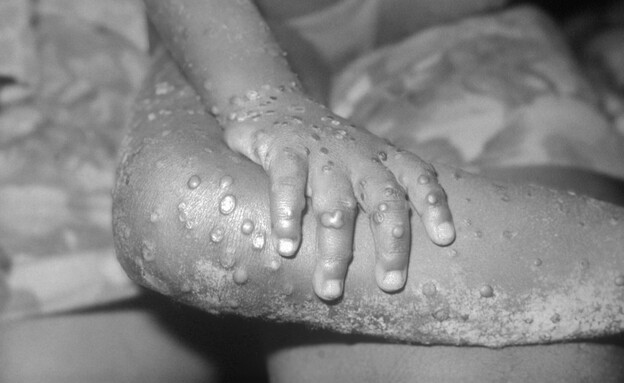The simplest way not to get an infectious disease is Stay away from sick people. Beyond that, it is important to maintain a balanced diet, among other things to prevent diseases resulting from a lack of essential substances for the body – for example, the diseasescurvy, Resulting from a deficiency in vitamin C – and having regular exercise that greatly reduces the risk of developing cardiovascular disease and is good for health for a variety of other reasons. And of course vaccines are a very effective way to prevent disease and suffering.
What diseases can be eradicated?
The thing we would like most of all is to eradicate all diseases. It could have been wonderful to live in a world where there is no more hypertension, tetanus or cystic fibrosis. Right? In practice, most diseases will remain here for many years to come, but a minority can certainly be got rid of forever. It is certainly possible to get to a point where no baby will suffer from deafness due to congenital redness, or late encephalitis due to measles.
In order to eradicate an infectious disease, at least two conditions must be met. First, it must be specific, meaning it can only harm one species of animal. Once the disease affects more than one species, in most cases it will not be practical to eradicate it, because it will always find a place to hide. Ebola, for example, erupts repeatedly in Africa when humans come in contact with infected animals, and become infected with the virus.
Another condition is that it must exist preventive treatment Very effective for the disease. If it cannot be prevented effectively, it cannot be eradicated, because there is always someone else who can get infected with it. However, sometimes it is enough to have an effective treatment for the disease that will prevent further infection. That is, someone who has already been exposed to the causative agent of the disease will get sick, but with proper treatment it can be prevented from infecting others. On this is based for example The plan to eradicate leprosy in India.
From prevention to extinction
The magic word in disease extinction is vaccines, which provide effective preventative treatment for a growing variety of diseases. Vaccines teach our bodies to defend against disease without having to get it. They prevent complications of illness, hospitalizations and death, and cost the public far less than the cost of caring for a patient in need of hospitalization. Most vaccines are easy to get from place to place and give to those who need them. Except for a few vaccines whose use requires a complex distribution system, most of which can be delivered in a simple cooler even to the most remote areas in the world.
The first human disease, and currently the only one eradicated by vaccination of all mankind was smallpox. The disease, caused by the variola virus, caused the development of blisters all over the body and in many cases led to pneumonia, encephalitis, organ collapse and death. The mortality rate ranges from a third of patients to close to one hundred percent of them in places not previously exposed to the virus at all. Contrary to popular belief, there is no connection between it and the black plague – Plague disease Which raged in 14th-century Europe, nor for chickenpox, which is caused by another virus.
In 1796 the English physician first discovered Edward Jenner An effective and safe vaccine against smallpox. He noticed that dairy women almost never get smallpox, and assumed that it was due to their exposure to cowpox – a cattle disease that we now know is caused by a virus very similar to variola. Measured exposure to this virus does indeed create protection against smallpox, and for years we have thus been vaccinated against the disease.
In 1967, the World Health Organization concluded that the two conditions necessary for the eradication of smallpox do exist: the disease only affects humans and there is an effective and safe vaccine against it. Following this they announced A worldwide operation to vaccinate all of humanity Against smallpox. Ten years later the operation ended with great success. The last person to get smallpox contracted it in 1977 – and recovered. Three years later, in 1980, it was officially declared that the disease that had plagued humanity had disappeared from the world.

The next enemy: polio
Encouraged by the success of the smallpox campaign, in 1988 the World Health Organization announced that the next target for eradication was the polio virus, which causes a disease called “childhood paralysis”. In most infected people, the virus settles in the digestive tract and does not cause symptoms or simple intestinal disease, but in some cases it manages to pass from the intestines into the bloodstream and cause irreversible damage to the nervous system, which manifests itself in paralysis.
Pediatric paralysis also meets both criteria for extinction. The polio virus cannot exist outside the human body and there are two very effective and safe vaccines against it that were developed in the second half of the 1950s by scientists Jonah Salk and Albert Sabin. (Sabin). Salk’s vaccine is based on a killed virus and is given by injection, while Sabin’s is an attenuated virus given by drops in the mouth. According to the schedule of the previous extinction operation, the virus was supposed to disappear from the world even before the year 2000. And lo and behold, we are already in 2022 and for some reason the disease is still here. In fact, in recent weeks A new polio patient was discovered Right here, in Israel.
what went wrong? Nothing, and maybe everything. Not entirely clear. By the year 2000 polio had disappeared from most of the world – the American continent was declared polio free in 1994; Four years later the last patient in continental Europe was diagnosed in Turkey; In 2000 the entire region between Australia and New Zealand and China was officially purified from the virus. Only a few countries in Asia and Central Africa stood in the way of achieving the goal of a world without child paralysis.
Progress since then has continued sluggishly. In Asia, the giant Indian state will try a waistline and announce a boost to the polio vaccination campaign. The effort was successful and in 2014 it also joined the list of countries that are considered polio-free. But at the same time, many upheavals took place during these years – political, health and also the spread of blatant lies against vaccines. All of these came together and halted the polio vaccination campaign in Nigeria, Pakistan and Afghanistan. And because it is a contagious disease, it occasionally drips from them to other countries, as happened in 2013 when the virus Re-located in Israel, where he arrived from Pakistan via Egypt. Following a considerable effort by the Prime Minister of Nigeria, and talks with the rebels from the Boko Haram organization, they succeeded in eradicating polio there as well, and by 2020 the entire continent of Africa was declared Clean from the wild strains of the virus.
Now only Asia remains, or rather Afghanistan and areas in Pakistan Which are controlled by the Taliban, which does not allow representatives of the World Health Organization to operate on its territory. As long as there is polio in the world, the disease may return and we must continue to vaccinate against it. This creates a potential problem: the attenuated live vaccine is very effective and accessible, but because it has a live virus, there is a fear that the virus will change and become violent again. In developing countries in Africa and Asia, where only the attenuated vaccine is received, cases of paralysis as a result of a mutation in the virus of the vaccine are indeed rarely reported. It is very important to eliminate all polio in the world also so that we can stop fearing that the tool by which the disease has disappeared from most of the world will become a means of allowing it to return.
The mission is almost complete: Of the three wild strains of the polio virus that circulated around the world in 1988, only the first strain now remains. Zn 2 And variety 3 Have already become extinct And there is one more last effort to destroy the last remnants of polio in the mountains of Central Asia.

and what else?
And yet there is another disease that we have managed to eradicate almost completely in humans, and this time even without vaccines. All it took was one creative idea.
Get to know the Guinea worm (Dracunculus medinensis). It is a parasite, a freshwater swimming worm in Africa and India. When drinking worm-infested water, the parasite enters the digestive tract and gradually makes its way to the joints of the legs and other organs in the body and causes within all intense pain and infections. Eventually, when the patient re-enters a pool of water in an attempt to relieve the pain a little, the worm hatches an opening out through the skin, emitting a new cycle of offspring into the water. There is no vaccine against the guinea worm and there is no drug treatment or other medical solution against it. And if that is not enough, it can be infected more than once, because our immune system does not know how to deal with the parasite and does not develop immunity against it.
Furthermore, the worm can infect other animals besides humans, and at an early stage of its life cycle it must infect crab crabs (Copepoda) and grow within them. However it does harm mostly humans. Apparently none of the conditions necessary for the extinction of the parasite are met: the worm is not exclusive to humans and there is no vaccine against it.
And yet we are on the safe path towards the complete extinction of the parasite, and all thanks to a simple and effective contraceptive – a dense network for water filtration. Drinking directly from open water bodies in Guinea worm habitats has been banned. The net filters the parasites from the drinking water so that the person drinking them does not become infected. In the absence of human surrogates, most adult worms simply die. Thanks to this ingenious solution The number of patients in Africa has decreased Close to ten million in 1985, at least twenty in 2021.
Additional steps were taken to complete the task. At the same time as educating the population to drink only filtered water, targeted lakes were carried out in some lakes to exterminate the sturgeons living in them, in order to interrupt the life cycle of the parasite already at the premature stage. This combination of measures has achieved its goal and we are probably facing the complete extinction of this parasite. We will have to continue the steps for a few more years – and especially to stop the cases of infection in dogs and other animals – to make sure that there are no more guinea worms left in the wild, and in the end this terrible disease will probably disappear from the world!
Who is next in line?
After we finally get rid of polio, the intention is to direct resources to the eradication of two other diseases that only affect humans and there is an effective and safe vaccine against them – Measles and mumps.
Measles is a highly contagious viral disease that causes at least one complication in at least one-third of its patients. Among the complications: eye inflammation, ear infection, pneumonia, and in some cases encephalitis. And that’s not all. Even those who have passed the disease easily may develop years after recovery a late, incurable and fatal brain injury. Measles only affects humans and there is an effective and safe vaccine against it that came into use as early as the 1960s. So there is no reason we should continue to live in the world with measles.
rubella It is an unpleasant disease that manifests itself in rashes and coughs, among other things, but the desire to eradicate it does not stem from its direct damage, but from the complications it can cause. The soil virus is able to cross the placental barrier and cause severe complications to the fetus. If the mother is infected with the soil for the first time in her life during pregnancy, the virus can disrupt the growth of the fetus’ limbs and cause deafness, blindness, brain damage and more. The goal in eliminating the soil is to prevent serious harm to embryos.
Soil disease also affects only humans, and there is against it as well An effective and safe vaccine, developed in the late 1960s. The vaccine has already proven its success in preventing the disease, and in countries where the entire population is being vaccinated, the congenital earthworm syndrome has completely disappeared.

What about Corona?
Despite the existence of safe and effective vaccines against the corona virus SARS-CoV-2, which has caused the current global epidemic, we are currently unable to eradicate the disease. This is because the virus is also capable of infecting non-human animals, so it does not meet the first criterion for disease extinction. Also, the protection against infection, of people who have survived the disease or been vaccinated against it, fades within a few months and therefore cases of re-infection or of infection of vaccinated may occur. But who knows? Perhaps in the future science will find new solutions that will relieve us of the punishment of other infectious diseases and fulfill the overarching goal – to prevent unnecessary suffering.
